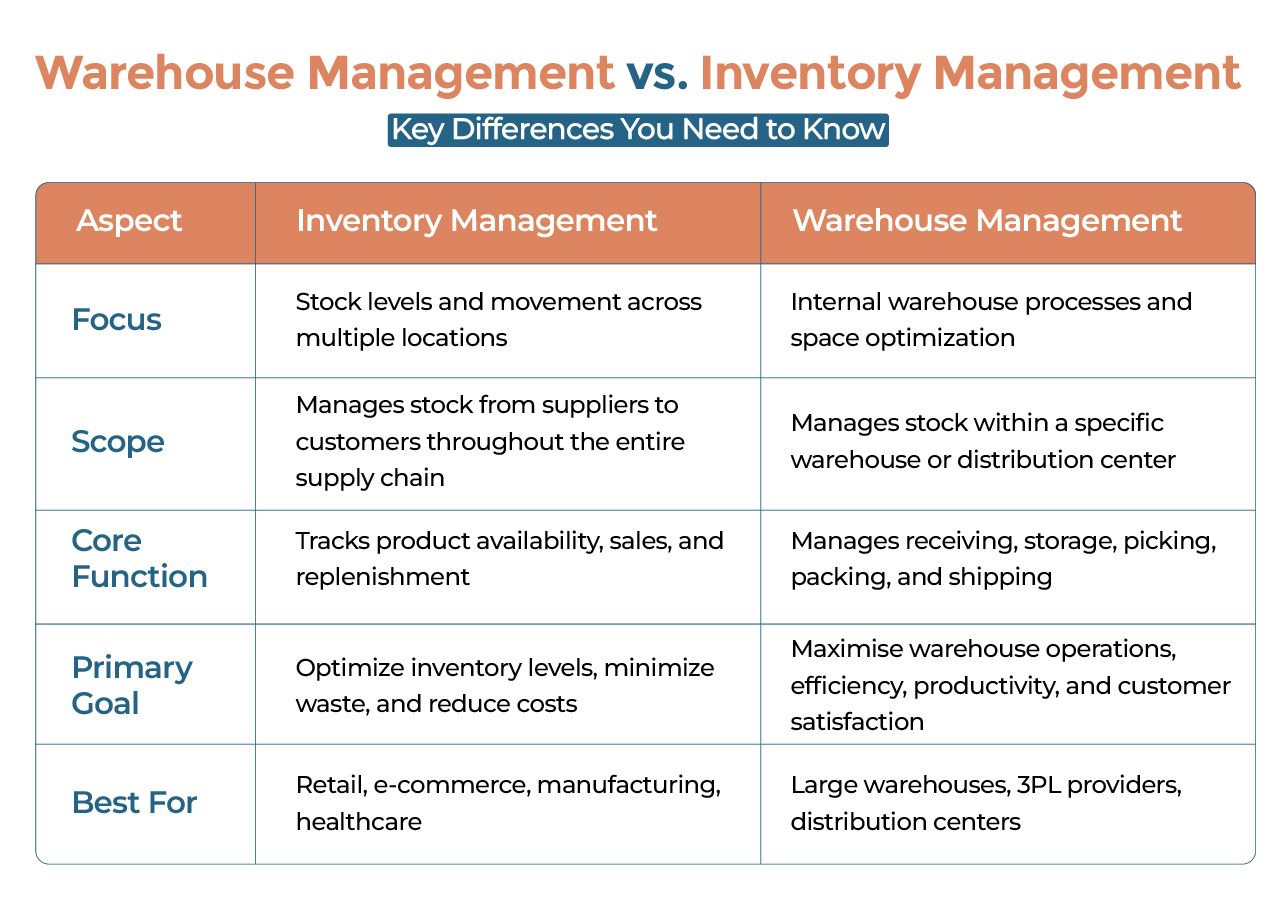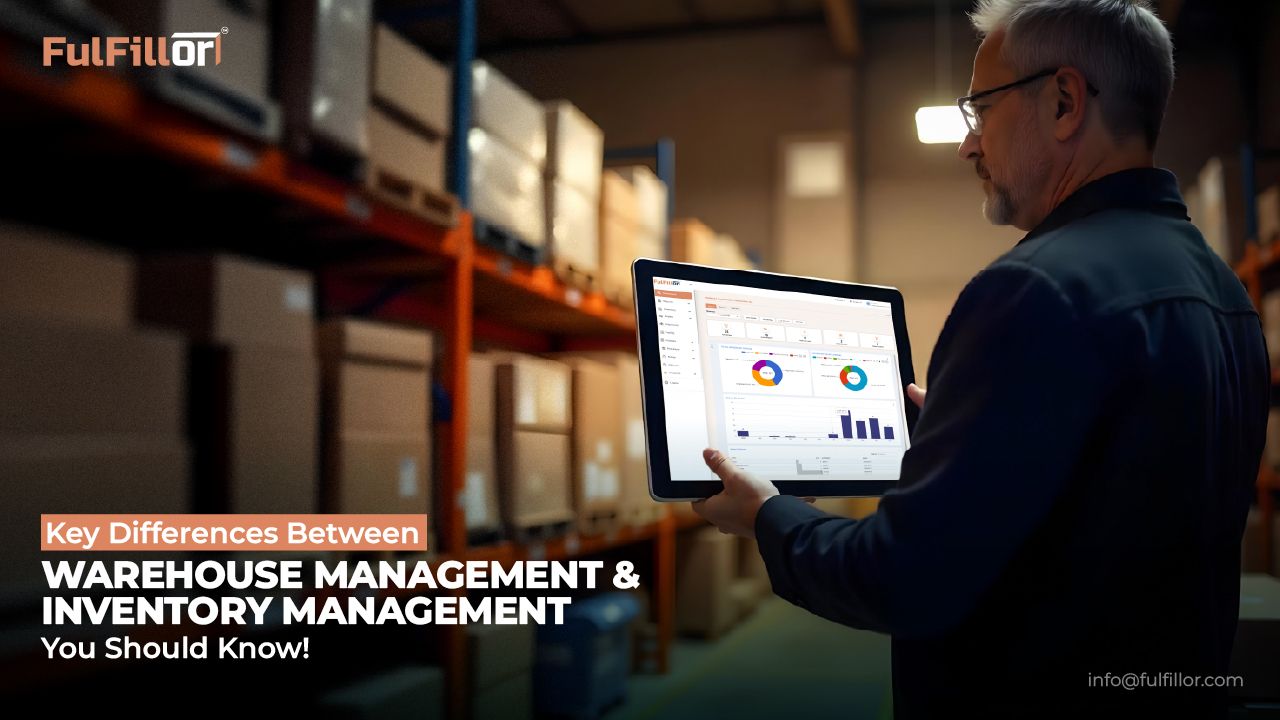Warehouse Management vs Inventory Management: What’s the Difference?
Key Differences Between Warehouse Management and Inventory Management: What You Need to Know
During the early years of my professional life, I often find it difficult to differentiate between warehouse management vs inventory management. Various other terms sound similar but they are not, making it challenging to understand their meanings and use.
Inventory management focuses on monitoring and controlling stock levels, while warehouse management involves overseeing the entire storage, movement, and organization of inventory within a facility. These are two closely related concepts and are essential to supply chain management. They operate hand-in-hand but still have different roles.
Want to know what exactly these terms mean and what distinguishes them? Dive into our blog and discover how these similar concepts serve different functions in optimizing operations.
What Is Inventory Management and How Does It Benefit Your Business?
Consider a fashion retailer who wants to know when a best-selling dress is close to being sold out and reorder before it is out of stock. This is the time when the use of an inventory management system comes in. Inventory management is all about — what you have, how much you currently have, and where it is stored. It focuses on the process of monitoring, maintaining, and controlling stock levels including ordering, storing, and stocking products. Inventory management ensures that the right kind of products are available in the right amounts, at the right time, and at the right cost. Tracking stock levels, locations, and stock movements across multiple channels also comes under inventory management.
Below are the key features of inventory management which include:

- Inventory tracking
- Order Reorder Management
- Stock optimization
- Multi-channel syncing
- Inventory Valuation
- Reporting and analytics
- Batch & Expiry Tracking
What Is Warehouse Management and How Does It Optimize Operations?
Key Functions and Benefits of Warehouse Management:
Warehouse management, however, deals with – how you organize, transport, and control your stock within a physical location. It does more than just track inventory—it streamlines warehouse operations, logistics, and workflows to enhance efficiency. A Warehouse Management System (WMS) can assist in managing, receiving, storage, picking, packing, and shipping orders. Warehouse management is all about managing the physical space, labor, and equipment to ensure proper operations and optimize throughput.
Some key features of Warehouse Management include:

- Warehouse layout optimization
- Order fulfillment management
- Inventory receipt and storage
- Automated task assignments
- Real-time stock visibility
- RFID & Barcode Scanning
Warehouse Management vs. Inventory Management: Essential Differences for Optimizing Your Supply Chain

1. Operational Depth and Effectiveness
-
Inventory Management is the planning of stock based on several parameters like demand forecasting, relationship with the suppliers, etc. It guarantees stock precision by stopping the company from overstocking or running low on essential items.
-
Warehouse Management optimizes internal warehouse operations and processes for receiving, picking, and shipping to ensure maximum efficiency and throughput.
2. Cost and Implementation
-
Inventory Management gets less expensive, and typically requires lower first investments, making it more suitable for small to mid-sized businesses.
-
However, Warehouse Management systems need special software, hardware ( like RFID, and bar-code scanners), and automation tools, thus they require higher investments, and they reduce operational costs and improve warehouse productivity.
3. Scalability and Flexibility
-
Inventory management systems are quite scalable as they sell across multiple sales channels (Amazon, Shopify, Walmart, etc.),
-
Warehouse Management is pretty much the same thing but WMS scales with size, complex nature, and degree of automation of the warehouse.
4. Integration and Accuracy
-
The Inventory Management System integrates perfectly with other business systems such as ERP (Enterprise Resource Planning) , CRM (Customer Relationship Management), accounting software, etc., to enable accurate and on-time data exchange and improved tracking of funds.
-
The Warehouse Management System integrates with inventory management systems and other warehouse systems including automated storage and retrieval systems (AS/RS) and conveyor systems. It interlinks with logistics (FedEx, DHL, UPS) and robotics to optimize warehouse flow and boost warehouse efficiency.
5. Inventory Management and Visibility
-
Inventory Management allows you to see all of your local inventory distributed across stores; and monitor and track stock levels and how your inventory moves, especially across multiple warehouses. You can also see and keep track of what items are moving slower than normal and get stock alerts.
-
Whereas Warehouse Management involves organizing the stock to provide real-time visibility into the location and status of inventory within the warehouse for greater inventory control.
6. Operational Scope
-
There is much more to inventory management than managing the warehouse — it encompasses every link in the supply chain, from raw material (procurement) to end product (delivery). It runs on an enterprise level and helps companies manage inventory from suppliers to customers in multiple warehouses, distribution centers, and retail stores.
-
Warehouse Management manages operations like receiving, storage, and shipping of goods within the four walls of a warehouse to ensure smooth operations.
7. Process Optimization
While both have similar goals of process optimization, they are different in their focus.
-
For instance, inventory management is concerned with optimizing processes related to inventory, like ordering and replenishment.
-
WMS not only involves receiving, storing, picking, packing, and shipping but also integrates with other supply chain processes, such as inventory management, transportation management, and order fulfillment.
Conclusion
Which solution do you think best fits your business needs—Inventory Management or Warehouse Management? You can choose an Inventory Management System if you only require stock tracking across many locations, syncing to online shops, and stock count. However, if you’re looking to maximize the use of warehouse space, reduce the time it takes to fulfill an order, and minimize picking and packing errors, opt for a Warehouse Management System.
For businesses processing a large volume of Orders and complex logistics processes, a combination of systems including robust, flexible Fulfillor’s Warehouse Management System and Inventory Management capabilities will be an ideal solution.
Reach out to Fulfillor for a tailored solution that complements your business requirements! Request a product demo today!

